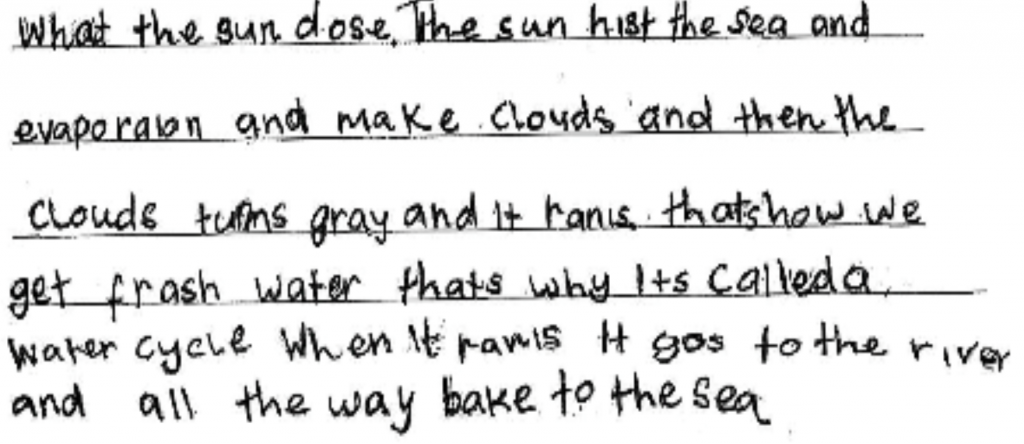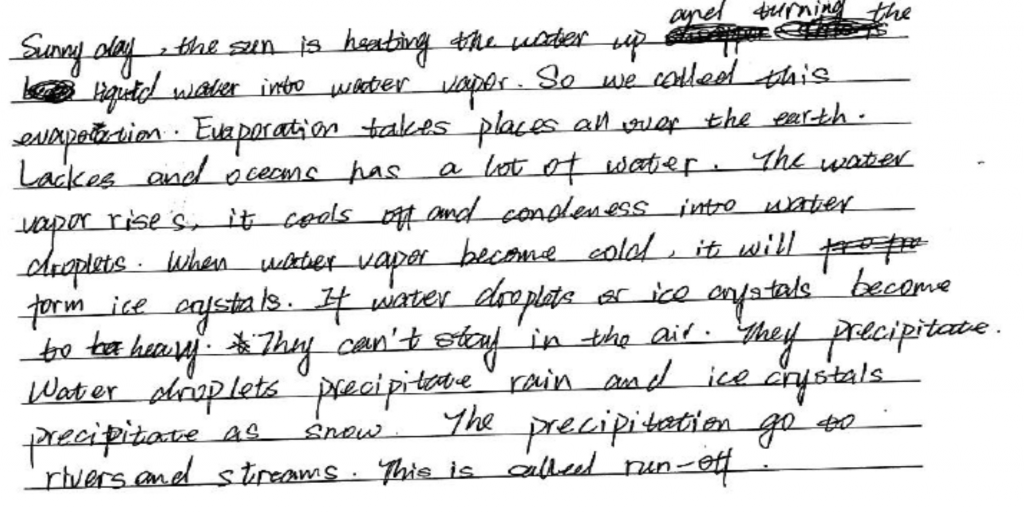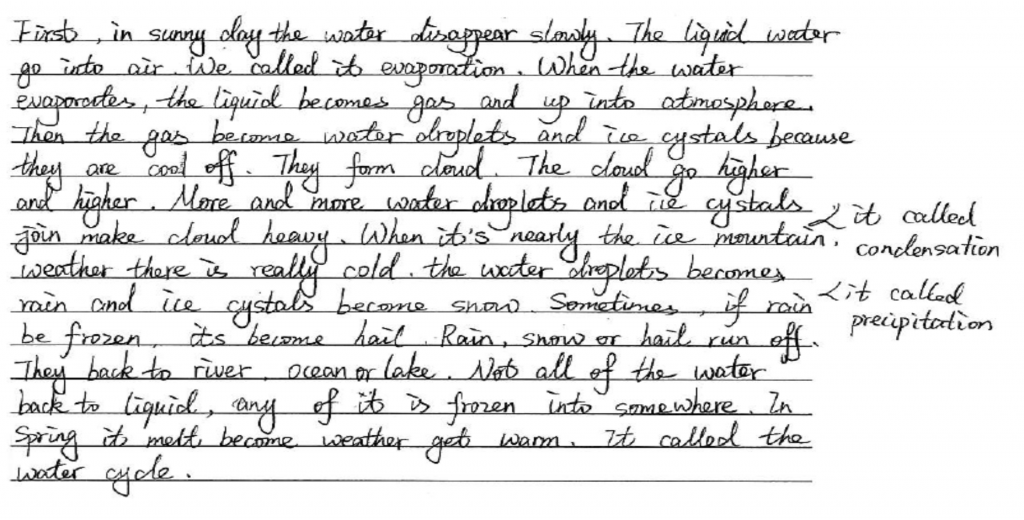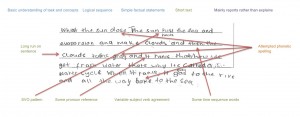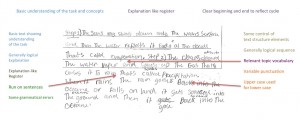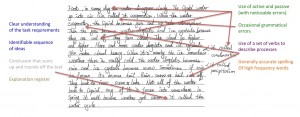21. An explanation of the water cycle
Please click on the toggles below to navigate through information on this assessment task and reveal the links for downloading task materials.
Task details |
|
| Name of writing assessment task | An explanation of the water cycle |
| EAL curriculum level range | B2, B3, C2, C3, C4 |
| Text orientation | Informative |
| Task type | Cued response |
[/toggle]
Task specification |
|
| Purpose | To assess students’ ability to explain a process: the water cycle |
| Description | Students are given a diagram of the water cycle. Learners use the diagram to explain the process in writing. |
| Assumed knowledge and description |
|
Learning/teaching context |
|
| Language centre/mainstream class | Mainstream class – EAL support |
| Subject/key curriculum objectives, outcomes | Geography, Science |
| Topic/teaching unit | The water cycle |
| Assessment conditions |
|
| Notes |
|
Task implementation |
|
| STAGE | ACTION STEPS |
| Pre-assessment activity |
|
| Assessment activity |
|
| Post-assessment activity |
|
TEAL Writing Task 21 – unmarked criteria [PDF]
TEAL Writing Task 21- unmarked criteria [Word]
An explanation of the purpose, nature and use of criteria sheets is available at 4. Using the assessment criteria.
Purpose and nature of the task
The task involves the students in writing a paragraph describing the water cycle. They use a simple diagram to support them in their writing. This task assesses the students to write a basic information text, using structures such as present tense to explain a process, active voice and passive voices, time sequencers, such as then, next, after. The task also involves using the key vocabulary relevant to the water cycle, such as ground water, lakes, soil, the sea, water from ocean, to evaporate, to condense, precipitation, surface run off. This task is related to TEAL Oral Task 14: Describing a cycle.
Commentary
Samples 1 and 2 were written by primary students, and Samples 3 and 4 were written by secondary school students. Their English language proficiency levels are different, but there writing also reflects differences in cognitive skills and understanding between primary and secondary students, and illustrate how texts reflect both language skills and the cognitive skills and understandings of the students who write them.
Biographical information:
Year: 5
Home language: Sudanese Arabic
Commentary
This sample shows that the student understands the task. The writer produces a text which tells the reader about the stages in the water cycle. By beginning and ending with the sea the structure of the text reflects the water cycle.
The first marked sentence is an attempted subheading.
The rest of the text is an extended run-on sentence. Verbs are consistently in the timeless present tense (turns, ranis, and gos) and subject-verb agreement is variable (the sun …make, it gose).
Although the pronoun ‘it’ is used to refer to rain, no pronoun is used for clouds, and first person ‘we’ is inappropriate. Some of the spelling errors are attempts at phonetic spelling (frash, gos, bake), while others show incorrect sound-letter sequence (ranis, dose)
The marked criteria sheet shows that the student meets most criteria at Level 1 of performance.
The student’s language use in this task is consistent with the descriptions of students at Level B2, Victorian Curriculum F-10 EAL.
Using this assessment to further learning
(Select the points you think are currently of most importance to the student.)
- Sentence structure
Ask the student to read the text aloud. When the student pauses, explain that this can indicate the end of the sentence. Add full stops and capital letters to show sentence punctuation. Alternatively, read the text to the student, pausing in appropriate places to emphasise the sentences.
2. Pronouns
Point out the correct use of it after when it rains. Explain how the pronoun it is used instead of the noun rain. Ask what pronoun could replace clouds at the beginning of the third line.
| When the sun hits the sea, it causes evaporation. |
| Condensation makes clouds and then they turn grey and it rains. |
3. Subject-verb-object (SVO) patterns
Show the SVO pattern using simple sentences. Explain the subject-verb agreement for singular and plural.
|
Subject |
Verb |
Object |
|
The sun |
hits |
the sea. |
|
Condensation |
makes |
cloud. |
|
Clouds |
make_ |
rain. |
Give the student time and support to write up another draft to see if an improvement can be made on the selected issues above
Add the final draft to the students portfolio.
Biographical information:
Year: 5
Commentary
This sample shows a basic understanding of the task and most processes involved in the water cycle.
The student has relied on teacher support (Thats called evaporation. …couses it To rain That’s called precipitation.).
Then and When are used to sequence events.
Simple factual statements (it gose Back into The oceane) are incorporated into the run on sentences.
Subject-verb agreement is accurate.
Punctuation is variable, with the letters t and b always written in the upper case at the beginning of words. Full stops are used intermittently, apostrophes of contraction are not used.
Some challenging words are spelt correctly (clouds, ground, precipitation), and others have been attempted (oceane, souced).
The marked criteria sheet shows that the student meets criteria at Level 2 of performance.
The student’s language use in this task is consistent with the descriptions of students at Level B2, Victorian Curriculum F-10 EAL.
Using this assessment to further learning
(Select the points you think are currently of most importance to the student.)
- Sentence structure
- Ask the student to read the text aloud. When she pauses, explain this indicates the end of the sentence. Add full stops and capital letters to show sentence punctuation.
2. Sentence punctuation
- Once sentences are indicated by full stops, circle upper case letters that have been used appropriately. Ask the student to correct other uses of upper case that are incorrect.
3. Apostrophes in contractions
- Show the student how apostrophes are used to indicate a missing letter in contractions.
|
Two words |
Contraction |
|
That is. |
That’s |
|
That is called…. |
That’s called |
|
It is raining. |
It’s raining |
|
He is swimming. |
He’s swimming. |
Give the student time and support to write up another draft to see if she can improve on the selected issues above
Add the final draft to her portfolio.
Biographical information:
Year: 9
Home language: Chinese
Commentary
The text clearly explains all the processes of the water cycle. Some elaboration is included (Water droplets precipitate rain and ice crystals precipitate as snow).
Timeless present tense is used almost exclusively (will is used once to explain cause and effect), although some subject-verb agreement is incorrect (Lakes and oceans has..). Third person pronouns are used appropriately, however, the explanation register would be improved without the use of we, and by avoiding colloquial language such as a lot of and can't stay in the air.
The marked criteria sheet shows that the student meets most criteria at Level 3 of performance.
The student’s language use in this task is consistent with the descriptions of students at Level C3, Victorian Curriculum F-10 EAL.
Using this assessment to further learning
(Select the points you think are currently of most importance to the student.)
- Colloquial to formal
Ask the student to read the text and identify expressions that sound too informal or like spoken language for an explanation text.
Use the table to suggest alternative expressions.
|
Spoken |
Formal (written) |
|
A lot of water Stay in the air We call this is evaporation. When water vapour becomes cold |
Much, a large quantity of water Remain in the air This is called evaporation./This is the process of evaporation. When water vapour cools |
2. Subject-verb agreement
To increase accuracy with subject-verb agreement complete a table to identify whether the subject is singular or plural, and circle the appropriate verb form.
|
Singular/plural |
Subject |
Verb |
|
Lakes and oceans |
has/have |
|
|
Precipitation |
go/goes |
|
|
Water vapour |
become/becomes |
3. Complex sentences
Point out the correct sentence beginning with a dependent clause (When water vapour….). Ask the student to read the next two marked sentences aloud. Show how the ideas are connected. Discuss the sentence patterns in the first two rows, and ask the student to complete the remaining complex sentences, adding the main clause at either the beginning or the end of the sentence.
|
Main clause |
Dependent clause |
Main clause |
|
If water droplets or ice crystals become too heavy, |
they are precipitated. |
|
|
Water droplets or ice crystals are precipitated, |
if they become too heavy. |
|
|
When water vapour becomes cold, |
||
|
when water vapour becomes cold. |
||
|
As the water vapour rises, |
||
|
as the water vapour rises. |
Give the student time and support to write up another draft to see if she can improve on the selected issues above
Add the final draft to their portfolio.
Biographical information:
Year: 10
Home language: Chinese
Commentary
Despite grammatical errors, the student communicates well and shows a good understanding of the task requirements.
Information is sequenced logically and temporal and causal indicators make the meaning consistently clear.
The concluding three sentences elaborate on his understanding of the ongoing and extended nature of the process.
Sentence types vary, including a complex sentence with a dependent clause embedded in the main clause, (Sometimes, if rain be frozen, its become hail.). SVO pattern is used inconsistently, and subject-verb agreement is incorrect. Timeless present tense is mainly used and passive voice is attempted (they are cool off; if rain be frozen; any of it is frozen). All spelling is correct, including challenging words.
The student’s ability to construct the text is stronger than his control of grammatical sentences. Most criteria met at level 4 are related to the structure and nature of the text, while those at level 3 relate more sentence-level grammar.
The marked criteria sheet shows that the student meets criteria at Level 3 of performance.
The student’s language use in this task is consistent with the descriptions of students at Level C3, Victorian Curriculum F-10 EAL.
Using this assessment to further learning
(Select the points you think are currently of most importance to the student.)
- Subject verb agreement
Show the student the chart below and see if he can identify and circle which verb option is correct and ask him to explain why. Clarify any gaps he has about this.
|
Subject |
Verb |
The rest of the sentence |
|
The liquid water |
go / goes |
into the air |
|
The gas |
become / becomes |
water droplets |
|
The clouds |
go / goes |
made… |
|
The water droplets |
become / becomes |
released.. |
|
Water |
melt / melts |
frozen.. |
2. More technical expressions
Ask the student to look at the table below and to see if he can add the more technical expressions to his text.
|
In text |
More technical vocabulary |
|
To go into air |
To turn into vapour |
|
To go up into the atmosphere |
To rise into the atmosphere |
|
To go back to the river |
To return to the river |
|
To go back to liquid |
To return to liquid |
3. Passive voice
Remind the student that sentences can either be in the active or passive voice.
A useful rule of thumb is: When we use the active voice we want to focus on the DOER of the verb NOT on the ‘receiver’.
So, the DOER of the verb goes in front position:
|
DOER (front position) |
VERB |
RECEIVER (end position) |
|
Paul Water droplets Water droplets Ice crystals |
drives form form form |
the car clouds rain snow |
A useful rule of thumb is: We use the passive voice when we want to focus on the RECEIVER of the action NOT on the ‘doer’. SO the RECEIVER of the verb goes in front position and we make the verb passive by adding a form of the verb ‘to be’ + ‘pp’
|
RECEIVER (front position) |
VERB |
DOER (end position) |
|
The car Clouds Rain Snow |
is driven are formed is formed is formed |
by Paul by water droplets by water droplets by ice crystals |
Also point out the following as ‘chunks’ of language rather than trying to explain it using the above tables. Explain that we use ‘This’ rather than ‘it’ to refer back to a process, for example:
This is called evaporation
This is called condensation
This is called precipitation
4. The use of some and any
The general rule of thumb is that we use some in statements and ‘any’ in questions and negatives. This might be a useful rule of thumb to point out here to see if the student can self correct the use of ‘any’ in her text: ‘Not all of the water returns to liquid. Any of it is frozen’.
Give the student time and support to write up another draft to see if he can improve on the subject verb agreement and/or technical expressions, and/or the use of the passive voice and/or the use of ‘this’ rather than ‘it’ to refer to a process and/or the use of ‘some in statement forms.
Add the final draft to his portfolio.

